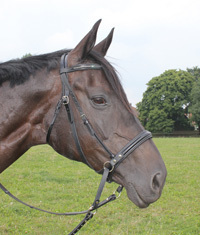Categories reference Claus Penquitt
reference Claus Penquitt

The Bitless Bridle in the "three-month trial" of 2007
The pros and cons when it comes to the bitless bridle is an ever popular subject for decades. Out of curiosity I tried out a variety of these, often too highly praised, bridles, so my list of complaints was ever more extensive. The advocated conservation and related relief of now bitless horses mouth proved in practice in various constructions such as not given.
My newly acquired and very difficult PRE stallion was obviously quite dissatisfied with his snaffle bit. The general coveted chewing the horse appeared to me as a nervous, frantic Gegnatsche. Then I discovered the previously unknown to me Bitless Bridle. Its amazingly useful design interested me. Here, neither the horse's mouth was pinched, yet his inner soft tissues were squeezed from the outside, as it has happened for example with lever designs.
For three months now I ride mine, as I have said quite a difficult horse. With the Bitless Bridle Since there's no more nervous Gnatschen. Focusing rather on my horse lightly plucked rein aids. Supported by appropriate body language required only one slight tug on one rein and the horse performs the desired direction of change. This reaction is initiated by, albeit simple, but useful construction of Bitless bridle by light carried by the one-sided Zügelzug an equally slight pressure on the opposite Ganaschenseite occurs.
Both reins, supported by an acoustic signal, should be adopted, the horse feels pressure on his nose and stops. The immediate surrender of the reins after stopping the horse shapes to the horse as a pleasant and it learns very quickly the consistent, prompt obedience to the desired stopping.
Now, after three months, constant use of the Bitless bridle, the horse makes both the step and in the trot and canter, a satisfied feeling. It reacts indiscriminately in all lateral movements and flying gallop required changes, as in the zigzag traversal as with a bridle with a bit of minimal rein aids. Whether the formation of a basic un ittenen horse, including subsequent lateral and vertical deflection, possible with a bitless bridle is, can not be judged by me, because I have this on such horses have not tried.
Claus Penquitt

